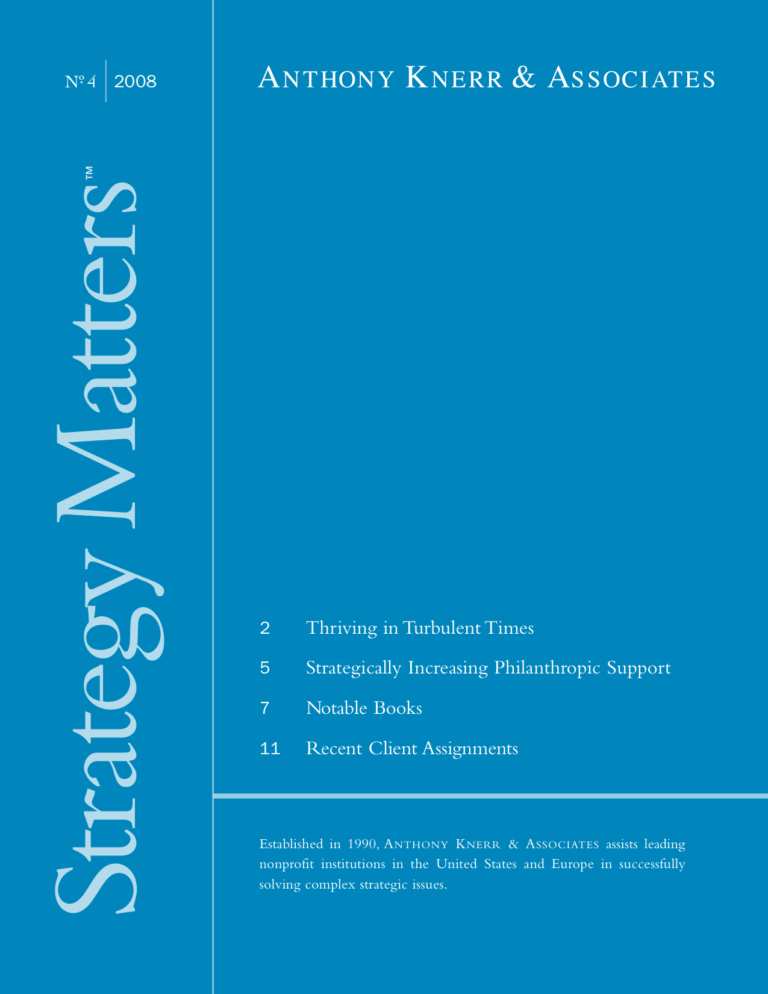Strategically Increasing Philanthropic Support
Although charitable giving may fall off by five to ten percent during the coming recession, the news is not all bad. The wealthiest donors are still well-positioned to make principal gifts. Thinking strategically and having a strong strategic plan is likely to help keep them attracted and will increase the likelihood of their continued support.
- The wealthiest one percent of families in the nation are, for the most part, unaffected by a three to five-year downturn in the economy. Those families have been, and are, the inheritors of the largest transfer of wealth in the nation’s history, even when diminished by market values in the short run. Their capacity to give remains virtually untouched in the longer run, though their portfolios may have taken a beating in the short run.
- The active philanthropists among this wealthy cohort are unlikely to decrease their support of the causes, new and old, that they cherish most. Recent data indicates that as the U.S. economy slows, these individuals and families are likely to give even more generously than they have in the past.
- While many individuals, foundations and corporations have lost significant wealth (or may do so over the next several years), others will find remarkable opportunities in the transformation of the American and global economy and become wealthy or wealthier—and, in turn, be able and interested in making consequential philanthropic contributions.
- In addition, much has been written about a new generation of philanthropists wanting to make a difference. They want more information and involvement than ever before. Arthur Brooks, author of Who Really Cares, notes that in addition to those receiving services, nonprofits must remember those who need to give to attain their full potential in happiness, health and material prosperity. Such donors can—and often do—make such significant gifts that they can move fundraising results to a completely new level of achievement and encourage other donors to follow suit.
Strategic planning offers superb opportunities to involve current and prospective donors, interesting and educating them in the challenges and opportunities faced by a nonprofit, even more so in times of financial stress.
Lessons From the 1970s
Peter McE. Buchanan
While current economic conditions are the worst since the Great Depression, a more recent period of serious economic turbulence is the 1970s, when the oil embargo, skyrocketing inflation and depressed financial markets lasted for most of that decade. The impact of those events on American philanthropy was decidedly negative. In 1972, gifts from individuals, outright and by bequest —accounting for over 80% of private giving in the United States—stagnated at $106.5 billion in 1972, declined to $99.3 billion in 1975 and did not exceed the 1972 level until 1977 ($108.2 billion). Gifts to educational institutions declined 8.6% and 13.5% in 1974 and 1975 respectively. Source: Giving USA 2008
- Most major philanthropists today—be they individuals or foundations—are far more interested in investing in a nonprofit organization to help solve major issues than in givingto a nonprofit because of its appeals for charity. Thus, nonprofits should view philanthropists as invaluable partners who bring particular perspectives, ideas and values, together with resources, to the table. While some philanthropists have well-considered ideas about what they wish to accomplish, and sometimes how they want to do so, many look to nonprofits to frame the issues, conceptualize the opportunities and articulate the possible results and benefits for them.
- Many major philanthropists have a long time horizon —they realize that significant societal issues cannot be solved overnight and understand that continued support is essential. They are thus similar to the most thoughtful nonprofits, which likewise have a ten, twenty or thirty- year vision of what they wish to accomplish and why their vision is of significance.
- While some philanthropists will sit on the sidelines until order and confidence is restored to the global financial markets—perhaps by necessity, often by design—most of them will not lose their interest, passion or commitment to their cause(s) and will appreciate being actively involved in an organization’s evolving strategic thinking. Continuing to build strong relationships with donors and prospects during difficult times will pay off handsomely when times are better.
Most major philanthropists today — be they individuals or foundations — are far more interested in investing in a nonprofit organization to help solve major issues than in giving to a nonprofit because of its appeals for charity.
There is increasing evidence of a positive correlation between successful gift acquisition and sound strategic planning processes. Thus, for instance, in recent years the largest individual gifts to higher education—each in excess of $10 million—went to institutions that had formal strategic plans and shared them with their donors. Scores of nonprofits in other sectors, including medicine, culture, the environment and social services, likewise indicate that their success in philanthropic support is a direct result of actively engaging major donors and prospects in their strategic planning.
The recent robustness of philanthropic support is likely to abate over the next several years as the financial markets correct themselves. But the wise nonprofit will continue to plan strategically, involve their donors in helping them realize their aspirations and seek opportunities to engage new prospects. Such actions are key to minimizing the negative impact of adverse economic conditions, maintaining high levels of philanthropic support and building even stronger giving results in the future.


